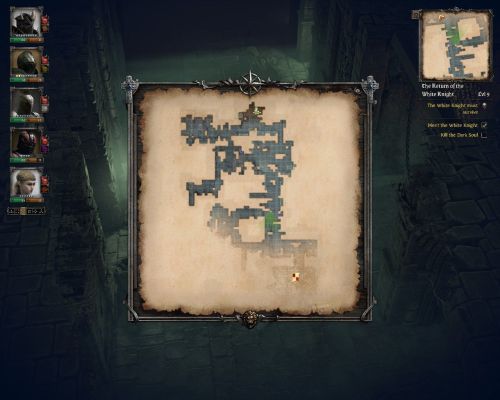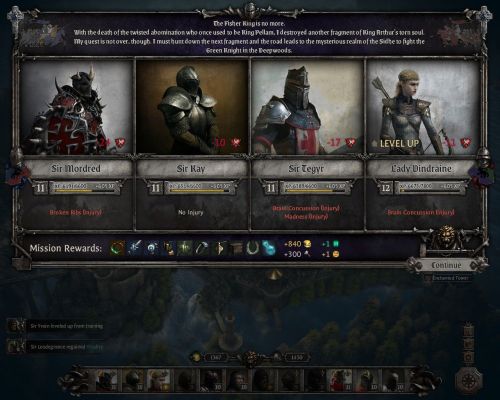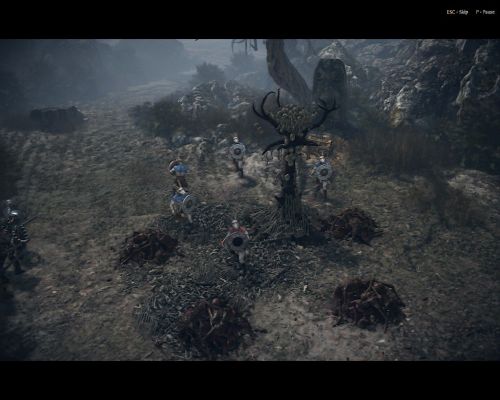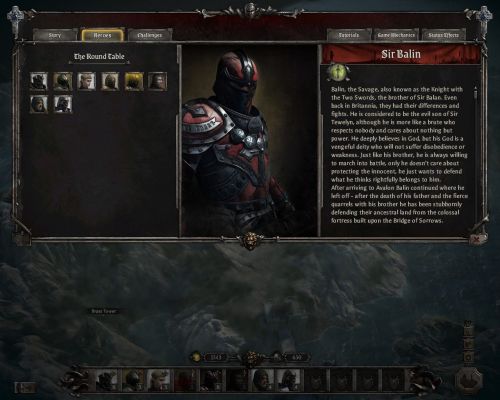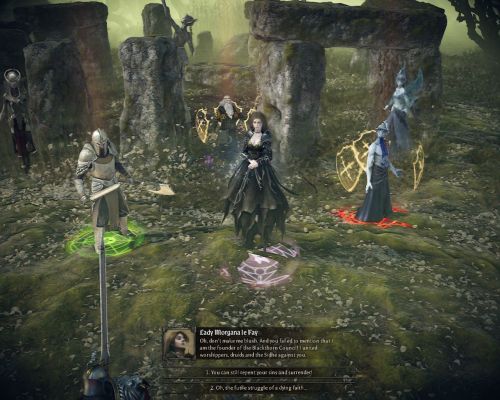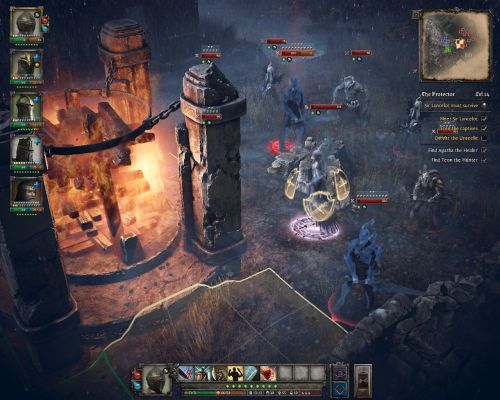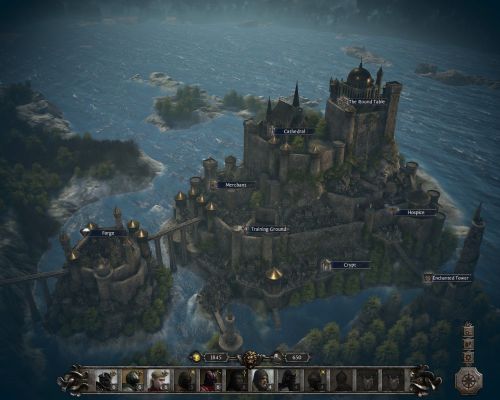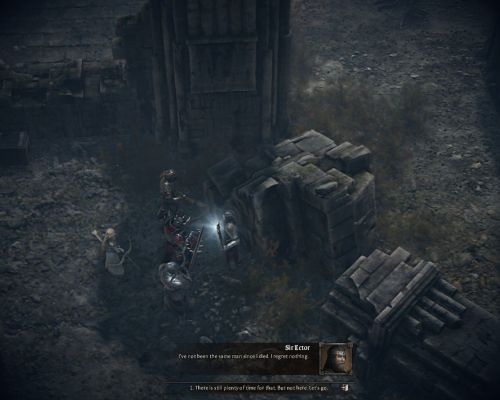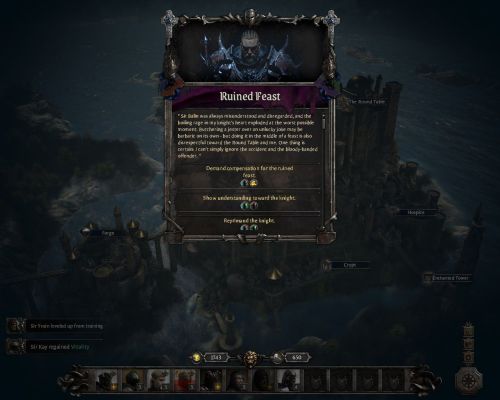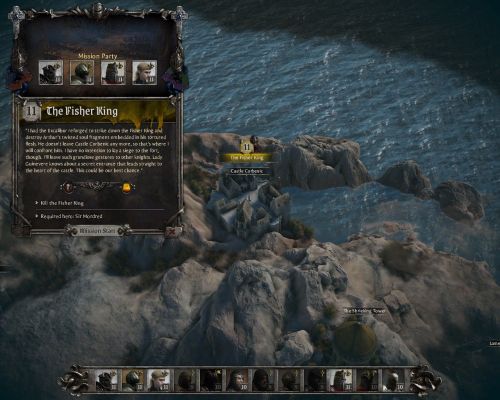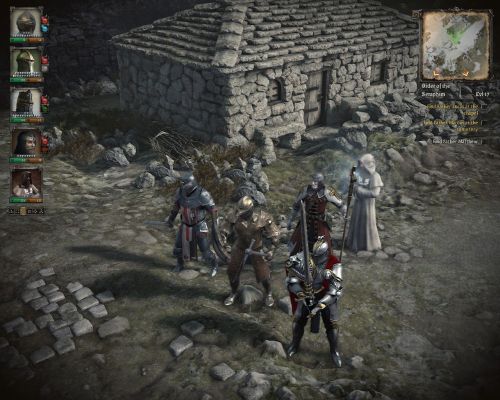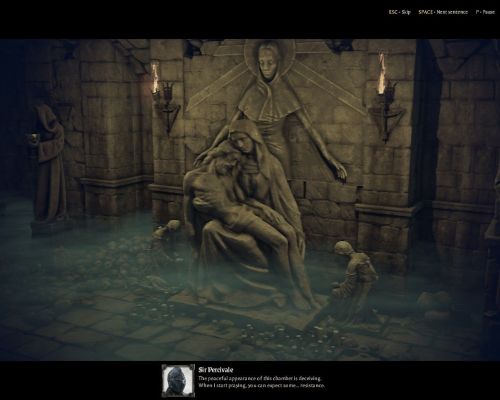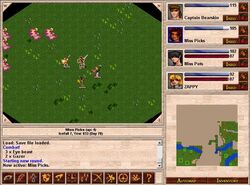RPG Codex Review: King Arthur: Knight's Tale
RPG Codex Review: King Arthur: Knight's Tale
Codex Review - posted by Infinitron on Sat 17 February 2024, 20:36:23
Tags: King Arthur: Knight's Tale; NeocoreGames[Review by Darth Roxor]
Back to the Once and Future
The year 2020 saw the success of yet another Kickstarter campaign. This time the people out for free money were the Hungarians of NeocoreGames, known for their cool King Arthur strategy games and a bunch of Diablo clones no one cares about, such as the Incredible Adventures of Van Helsing. The Kickstarter was launched to fund the development of a tactical turn-based RPG in the King Arthur series, titled Knight’s Tale.
As you may have inferred from the previous paragraph, Knight’s Tale immediately drew my attention. King Arthur: The Roleplaying Wargame might be one of my favourite strategy games of all time, and I never quite understood why they dropped the series to develop action RPGs, so merely looking at the various screenshots immediately made me feel at home.
Yet the developers never produced a game of turn-based tactics before, so naturally many people may be wondering whether Knight’s Tale is any good, especially given how easy this is to screw up. Now, two years after release and with a number of major patches applied, it is time to settle these doubts.
Time to Feed the Ravens
You are Sir Mordred. You killed King Arthur and he, in turn, killed you at the catastrophic battle of Camlann that saw the eradication of the Round Table. And yet something must have gone wrong, because you both still live. You awaken in a nightmarish Avalon that has been twisted beyond recognition by Arthur’s suffering, and the Lady of the Lake tells you to finish what you started and kill the king for real.
That’s the game’s setup. We’ll explore it in greater detail in the next section, while for now we’ll focus on the primary thing that matters here – the combat.
To start with the basic idea, Knight’s Tale has you take a party of four brave knights (out of a maximum of twelve at your headquarters in Camelot) on various missions that are all resolved by vanquishing the enemy. When a mission starts, you land on a map that your party can move around in real time, with turn-based combat kicking in the moment you encounter any opposition. You could call this “Jagged Alliance style” if not for the fact that the enemies are all stuck firmly to their encounter zones.
The game is largely deterministic, but not completely so. Under normal circumstances attacks will always hit, though for variable damage, and the damage ranges are usually broad enough to make things less predictable. Furthermore, characters may gain special abilities with various random components: a chance to dodge attacks, to do double damage, to miss outright, and so on.
You could say that characters have three different ‘health bars’ to soak up damage with. The ‘topmost’ one is armour – it reduces all damage taken and goes down the more you get whacked, depending on an attack’s damage and armour-breaking values. Any damage that goes through armour is applied to hit points – this is your ‘safe’ health that can go down without any repercussions. Once HP is depleted, you’ll start losing vitality, and all damage into vitality can result in a persistent injury, while losing all vitality means permanent death.
This triple-health design is incredibly clever, for many reasons. Armour and HP replenish for free after every mission, and can also be restored in various ways during a mission, so you’re encouraged to make use of them and charge into the fray like a man. Meanwhile, vitality does not heal on its own, and to bring it back you have to bench a knight in the hospice in Camelot, which means he’ll be unavailable for a number of missions. Likewise with injuries, they don’t go away on their own either and have to be healed at Camelot’s cathedral, and given that their effects can be devastating, you’ll want to get rid of most of them as soon as possible. There’s also a fourth health element involved here, which are injury tokens – your knights can have about 0-3 of these, and they act as disposable shields against injuries.
Thanks to all that, you have to keep many things in mind when you go through combat encounters. Can I afford to risk the vitality damage? Will my defender’s armour hold? Will I do enough damage to break through armour and apply burning on that one guy? The damage formula itself can also be fairly complex given the number of factors that influence it, the chief of which is armour, especially during the first half of the game before the numbers get a little bloated. The intricacies of armour are still a bit of a mystery to me, but it acts as a wonderful “wildcard” in combat, and you’ll often be surprised upon seeing attacks doing no damage through it.
Damage is further influenced by facing. I feel like facing is a strongly underrepresented concept in games like these, and Knight’s Tale includes it in a manner that is both remarkably simple and very beneficial to the mechanics. Switching facing is completely free – you only click in a direction to have your knight face it. It’s very important to do so, because you’ll take extra damage from backstabs and decreased damage from the front if you’re using a shield. It’s simple, it’s elegant and it matters.
All actions taken during combat – from movement to attacking – cost action points. There are actually two types of these, standard and movement AP, though the latter is more of a bonus that you’ll only get under specific circumstances, and which can be spent only on movement. Otherwise, it’s the regular AP that will govern all your actions. The AP costs and counts are another strong aspect of the game, because they allow you to execute a number of different actions during your turn – that is to say, it’s not another thinly-veiled “move and attack” system. Even without conserving AP between turns or boosting it through other measures, you can easily mark a target, approach it, attack and jump away to safety with your vanguard hero as part of your standard AP pool.
Finally, there is no initiative or turn order. All your units move during your turn, and you can switch between characters as they act at your leisure. Which side goes first depends on the circumstances, but it’s usually yours.
With these basics out of the way, I would like to state one thing very clearly. Knight’s Tale is a paragon of system design. I don’t remember the last time I played something that had mechanics this well thought-through – you can tell that Neocore was focused first and foremost on making the combat work. Usually in such games you can easily identify features that could be removed with no harm to the mechanics, or others that are cheap bandaids put on glaring issues, but here everything just clicks together organically. Likewise, it’s great that Knight’s Tale avoids the pitfalls of most deterministic systems, where the fights feel like chess puzzles to arrange and essentially ‘pre-win’ on turn 1. There are enough variables involved in combat to make sure that the fights actually play out on a moment-to-moment basis where plans can go wrong, forcing you to adapt to the consequences of failure and unforeseen circumstances on the fly.
Most importantly, all of this is accomplished without universal death timers or constantly spawning reinforcements, which are something I’ve learnt to very strongly loathe in modern ‘tactics’ games, which need to retreat to (and abuse) cheap tricks like that to offer any semblance of difficulty or variety in encounter design. Meanwhile Knight’s Tale hardly ever gets old despite almost never using anything of the sort. In fact, I don’t think I can remember a single instance of needing to win a fight within X turns. There are also no ‘puzzles’ to be had anywhere, in or outside combat, which is almost as surprising as it is refreshing, because these also tend to be forced in modern tacticals. Simply everything in Knight’s Tale is just about battle.
At the same time, although the missions are all about wiping out the enemy, they’re still diverse enough thanks to other factors, that ‘kill them all’ as the universal objective is never really a problem. For starters, the levels and encounters are all hand-crafted, and typically with a lot of care. It would be too much to call them ‘open-ended’, but being able to choose in which order you’d like to pick your fights still gives you a good enough sense of agency – this is made all the more obvious in the few missions that are actually railroaded. Furthermore, the maps have single-use campsites and shrines strewn about, with the former giving you a pitstop for fixing armour or HP and the latter working a bit like in Diablo, in that they have various effects that can be both positive and negative, adding another important element when it comes to planning your course of action in a mission. Finally, the locales are varied enough to give each level a different flavour, even if some of the maps are recycled to a certain degree. You’ll be busting your way through enchanted groves, wastelands, ancient crypts, battlefields, downtrodden villages and many more.
To return to the combat proper, another part that makes it an engaging experience is the enemy AI. Generally, the AI is pretty smart and will know to avoid dumb tricks like a waiting wall of massed overwatch – in fact sometimes it may even surprise you with tricks of its own. Different enemy types also have clearly distinct behavioural patterns, so for example undead will be pretty stupid and suicidal (these DO run into your overwatch), agile Pict warriors will be trying to flank you, armoured footmen will advance turtled up, brigands are flimsy and careful about approaching, and so on. I don’t think I’ve ever had to roll my eyes about the AI doing something stupid, and to me, that’s as much as should be expected from such a game. The only consistent problem I noticed is that the enemies can’t chain actions very well – for example, it happens regularly that the entire enemy force will move and whack you before its one support guy casts a party-wide damage buff.
Obviously the fights don’t revolve around just bashing stuff with identical attacks, so let’s take a look at how your knights differ among each other, and what skills they have at their disposal. There are six general character classes, and each knight has one pre-assigned that can’t be changed. These are:
- Defender (the facetank)
- Champion (the melee damage dealer)
- Vanguard (the glass cannon assassin)
- Marksman (the archer)
- Sage (the support caster/’cleric’)
- Arcanist (the offensive caster/’wizard’)
The classes have some specific general abilities (e.g. only the defender has ‘block’, which reduces damage taken from the front) and intended playstyles (you won’t make much of a tank out of a vanguard) as well as equipment access (only the marksman can use bows, defender and champion can’t wear light armour), but they mostly serve just as umbrella categories for quick reference. That is because the knights are primarily defined by their skill sets, and each of them has a separate unique one. Of course, many of the skills are shared among the archetypes, but no two characters have identical development options, and some knights within the same category can be very far apart in gameplay terms.
The skill effects are very broad and include just about everything you could think of for a tactical RPG – from fire arrows, through lightning bolts, shield charges, whirlwind attacks to curses – so I don’t think there’s much needed to be said here. Except, perhaps, that Knight’s Tale also has surprisingly few “hard disables” like stuns/knockdowns, especially for the first half of the game, and even then, their effects can be significantly reduced with mental/physical resistances.
Still, while the abilities may not be the most creative, perhaps, they get the job done right. The most important part is their sheer breadth and how they can be upgraded with new or better effects that will fit different characters or party setups in different ways.
In fact, this is another of Knight’s Tale’s major strengths – the party-building. Mind you, each knight’s skillset is tailor-made for a specific role or idea, and they don’t have that much potential for multiple different development paths. However, when you have twelve of these knights to choose from, and each one plays in a different manner, it makes for some excellent mixing and matching that influences how you’ll go through missions to a major degree. Furthermore, you’ll learn to spot synergies between them, or sometimes they might even come up organically in ways you wouldn’t plan for beforehand. You can have a glass cannon party focused on exploding the enemy before it gets exploded itself, or an assortment of defenders and champions ploughing forward like a juggernaut and shrugging off all attacks, or anything in-between.
Furthermore, since as you go through the game, you’ll naturally develop A, B and C teams, it can also be very fun to take the lower-tier party into action every once in a while to keep things fresh. Especially once your main force becomes so obscenely strong that it can just faceroll everything by merely looking at it.
Because this, unfortunately, is Knight’s Tale’s greatest weakness. I played on the hardest difficulty, and my experience with it was largely as follows. The first (of four) chapters is fairly challenging throughout. However, with each one after that, the initial stage is typically hard as you’re not yet familiar with the new enemies and such, but then you snowball into a state where the difficulty becomes a joke, until the next chapter starts and the cycle is reset. The later the chapter, the earlier you become overpowered, so the final one can be played on near-autopilot after just a few missions. There are of course exceptions in certain harder scenarios, but that was my general impression. It was also why in the late game I used my B-team much more often than the A-team, if only to just gimp myself and get some more fun out of the game.
I’m not entirely sure why this happens, though I have some suspicions. Firstly, it may just be that you typically see most of the new additions to the enemy roster early in each chapter, so there is little to surprise you as it goes on, or little actual growth in enemy power levels.
Secondly, I believe that the combat encounters tend to play it a little ‘too safe’ – that is to say, you aren’t often put against really bad odds other than through sheer enemy numbers. If, for example, the fights started with the enemy having first move more often, or with first move and more beneficial positioning in some kind of ambush, perhaps this would lend itself to a better challenge.
Thirdly, there’s a very surprising absence of some skills among the enemies, or they make very bad use of them, or they don’t even use them to begin with. The chief stinker here to me are the Sidhe of the Unseelie court. They’re the autumn/winter attuned edgy fairies, and they have a lot of special abilities that revolve around stealth, weather effects, and so on. But there isn’t a single enemy in the game that can actually use stealth. I’ve also only once seen an Unseelie witch cast a global fog spell that can screw your ranged dudes pretty badly, while a marksman was one of my primary damage dealers throughout the game.
That said, the game features a ‘roguelite’ mode that prevents you from saving manually during missions, so perhaps that is a good way of ramping up the difficulty. I could definitely see it being the case, given that I had to reload certain fights pretty often, and at some point I also grew rather reckless in combat, but I wonder if it wouldn’t be just a little too extreme on a first playthrough.
Finally, to close this section, since I touched on it above, one last thing I have to commend is the variety among the enemies. Each chapter introduces a new enemy ‘faction’ for you to face, which keeps things remarkably varied and fresh from start to finish, especially since the enemies from the previous chapters are also not completely discarded. Apart from the undead and various flavours of medieval humans, you’ll get to face the Sidhe and their changeling minions, Fomorian giants, perfidious pagan Picts and various disgusting beasts.
The Lord is my Witness
When you’re not driving back the tides of darkness, you’re managing your knights and kingdom on a big world map. Though that’s putting it a little generously, because the ‘management’ part of the game is rather slim.
To start with the kingdom (since Mordred officially crowns himself king after Arthur), you have your base of operations in Camelot, and that’s about it. Forget about taxing the yokels or mining for gold, there’s nothing of the sort here, and the big map is only a board for selecting mission tokens. Meanwhile Camelot is essentially a collection of upgradable buildings. Some of them are must-have, like the hospice and the cathedral for healing your wounded dudes, and some are more luxury picks, like the merchant for buying new equipment or the forge for upgrading it.
Developing Camelot isn’t exactly engaging, especially once you identify the ‘optimal’ course of building upgrades, but it does serve as a good enough money sink, especially early on. Although after you’ve built all the stuff you really want, the rest you kind of pick at random without much thought, because it’s hardly useful. Knights can also be assigned to supervise the buildings for additional bonuses, and some of them have unique abilities that require placing them in a specific building to work – this is a cool thing, because a character assigned to a building can’t be given a court title to increase his loyalty and, by extension, his combat performance, so sometimes you have to weigh your options accordingly.
As for the knights themselves, they’re definitely as much of a highlight in this game as the combat system. For starters, they all feel distinct – not just because of their different skill sets, but also because of their special traits and personalities. The traits can be positive or negative, and their effects vary wildly. For example, Sir Tegyr is a warden who gives everyone extra ranged defence when in charge of the forge. Meanwhile, the White Knight is a Christian missionary, who takes loyalty penalties for all your pagan heroes. And then there’s the good Sir Pelleas, who will refuse to go on a mission when injured or wounded. The traits alone give them a lot of flavour and often force you to adapt your gameplay habits or party compositions solely to appease their whims.
They can have additional personality quirks or associated side quests as well, though not all knights come with those. For example, Sir Balin is a restless daredevil, and he’ll keep vanishing on his own adventures all the time (though you can prevent him from doing so for a loyalty hit), while Lady Dindraine will ask you to let her go on a search for her brother Percival, and so on.
Furthermore, the heroes are all very colourful, to say the least. The idea in Knight’s Tale is that after everyone died in the battle of Camlann, they returned to life in Avalon, which as we know, is far from the paradise it ought to be. Thus, you can easily tell that dying and coming back has left all the knights kind of unhinged in their own ways. Some are really just loons, but in most cases it’s that their personal idiosyncrasies were dialled up to eleven, and that’s for both the do-gooders and the ne’er-do-wells. Their stories can often be clever and well-written, which is another thing that makes this game’s missions so cool to play.
Also, one thing that I believe is important to commend in this day and age, is the respect towards the source material and the audience when it comes to the heroes. There are no “female knights” per se, so noble ladies don’t take up heavy armour and poleaxes, the female characters are strongly in the minority, and there are no knights of unlikely ethnic origins. You’d think this wouldn’t even need mentioning, yet here we are.
Your character roster is limited to twelve heroes, which leads to terrible dilemmas as to whom to keep and let go, because the available knights number a lot more than twelve. Any new unlocked characters that don’t fit in Camelot are kicked into an ‘aspirant heroes’ pool, from which they can be freely taken out provided that you dismiss one of your current ones. And dismissed heroes are gone for good. I’m a little conflicted about this. I can understand the limitation to twelve knights, because anything else would have been impossible to manage with your limited resources, especially with regard to the number of characters taken on missions or put into the training ground for passive XP gains. However, it puzzles me why dismissed heroes are removed from the game instead of being placed in the aspirant pool. Kicking out knights that I’ve had for a long time to make space for new ones that were objectively better for my purposes proved to be excruciatingly difficult from a psychological point of view. Maybe it’s that effect of having one of your toys taken away? I don’t know. But I believe it could have been handled better.
Knights level up by acquiring XP, which is gained in three ways: participating in missions, going on adventures and training at the gym. The Camelot training ground can be expanded to four slots, where characters can gain XP when not on any assignment, at a rate of roughly 1/3 of a level per each mission you go on. Aspirant heroes also level up passively so as not to fall behind too much, but that upscaling can’t take them higher than three levels under your strongest character.
When reaching a new level, a knight gets two skill points that can be allocated across his skill tree – learning new skills takes two points, upgrading them takes one, and each skill has four upgrades to pick from. The tree is divided into three tiers that become unlocked the more points you spend. However, levelling up doesn’t increase any of the character’s stats, such as HP, damage, and so on – these have to be boosted through equipment.
Itemisation in Knight’s Tale is so-so. Each character has four item slots – armour, weapon and two accessories. Item drops during missions, I believe, are random, and so are the selections available at the merchants, so you don’t have all that much control over your loadouts. Overall, the items are fairly trashy, and their properties are mostly limited to +damage here, +HP there, and so on. The exception are relics, which are rare and with truly unique properties. Relics can go a long way in filling out gaps in your party compositions or opening entirely new options. Some examples include stripping attacked enemies of their AOOs, percentage chances to deal double damage, or diverting a part of the damage taken by the entire party to a single character. Their features can be powerful enough to make you hold on to them even long after their damage values have fallen behind relative to new, stronger stuff that’s dropped in later chapters.
Items can also be upgraded at the forge, but the forge is kind of dumb. It has three functions: a simple upgrade to the damage/protection values, reforging an item to a higher tier (from a “chapter 2” to a “chapter 3” item), and reforging to a higher rarity (e.g. from “rare” to “relic”). The problem with the latter two is that any item reforged in this way has all its properties rerolled, which means the “upgrade” can leave you with something completely worthless. I’ve only ever made use of the simple upgrade, because the rest is simply too unreliable.
Finally, I mentioned loyalty, pagans and Christians before. This is the last thing that makes up a knight – his alignment. There are two ‘morality axes’ in Knight’s Tale, same as in the previous King Arthur games – tyrant vs rightful ruler and Christianity vs old faith. Knights can be of any alignment, including neutral, and how their worldview differs from yours is one of the chief things that determine their loyalty. Loyalty is a tiered counter with thresholds at mirrored negative/positive values that influence a knight’s damage and AP count. You want to have that maxed ASAP. I don’t know if strongly disloyal knights can leave your service, since I never pissed anyone off that bad, but I don’t think so. Still, someone with -20% damage and -1 AP is only waiting to get kicked out anyway.
Though Mordred’s sins in life were many (including slaying the last native Briton king and opening the way for Germans), even he is not beyond redemption, so he starts with no loyalty or alignment because, well, you are Sir Mordred. The decisions you take during the campaign advance you along the morality axes, and each path comes with its own benefits. There are various unlockables associated with your alignment, from new recruitable heroes through building upgrades to laws and decrees that can be passed at the Round Table for temporary or permanent benefits.
The choices that influence alignment are another mixed bag. One thing to appreciate is that ‘tyrant’ vs ‘rightful’ does not translate into ‘asshole’ vs ‘saint’. For example, when determining what to do with traitors, it’s actually the rightful thing to execute them all, while the tyrant option is to ‘pardon’ them and make them work overtime. Though the best aspect of the choices by far is that they’re pragmatic decisions that matter to you as the player, rather than involve the dilemmas of pixel people. This makes weighing the rewards and drawbacks behind the choices much more compelling.
Unfortunately, the setbacks associated with the choices are way too rare or way too forgiving. Especially as the game goes on, it feels like the various events stop caring and quite literally change into: “+1 Christian vs +1 pagan, which is better and why?” This was much more nuanced in the King Arthur strategy games, and sometimes you really needed to skip a preferred alignment option or even take the opposite one, because otherwise you’d be setting yourself up for disaster. This happens very rarely in Knight’s Tale, which is a shame, because in the first chapter you do run into plenty of heavier dilemmas, including such that can kill off potential heroes.
Also, when an event appears, to resolve it you usually have to assign a knight to it. This I quite liked for a number of reasons. First, victorious knights typically get a loyalty and XP boost, so this is a good way of appeasing some of the more unruly heroes. Second, the questing knight will be unavailable for a mission’s time, meaning that it’s not always a no-brainer who to send where. Third, a quest can be failed, meaning the knight might just as well lose loyalty or get knocked out for even longer because of an injury. And finally, the events require you to pay attention – if the local druids are asking you for help with a ritual and you send a Christian zealot to assist them, you might be in for a bad time.
When it comes to what the missions, events and whatnot are generally about, Neocore’s grimdark take on the Arthurian legends is as cool as ever, and many things about Knight’s Tale will be familiar to you if you played the strategy games. The clash of Christian and pagan themes, of Celtic mythology and chivalric romance, of the pure old-fashioned struggle of good against evil is very compelling. It has to be said that while the game may feel and look all doom and gloom at first glance, there is actually a prominent chivalrous angle from which everything is presented. You are bringing the light back to Britannia and fighting to drive the rot back from Avalon, and you do it with an entourage of valiant knights who are very much bound to their duty. People may scoff at ‘knightly fiction’ and call it ‘generic’ or ‘overdone’, but I dare say that actual stories of chivalry are criminally underrepresented, and Knight’s Tale definitely delivers on that front.
However, funnily enough, the Arthurian themes themselves leave a lot to be desired, and many of them feel tacked on, as if crossed out from a list of ‘you need this in your Arthuriana’. Why is Camelot even in Avalon to begin with? I guess maybe you could look at it as a clever way of saying that the Round Table is Camelot, and the castle followed it after death, but still. Then there’s the Excalibur, which just sort of appears in a main quest or two and that’s it. Although none of it is as bad as the Holy Grail, which quite literally turns out to be the friends we made along the way, not to mention that the matter of the Grail is only resolved in a mere side quest.
Finally, there’s the main storyline. Honestly, the less said about it, the better, because the main quest is just kind of dumb. Your mission is to kill King Arthur. Unfortunately, his soul split into a bunch of fragments and settled in different places, so in each chapter you have to kill him again. There is some kinda-sorta hinting at something more going on, but it never leads anywhere and ultimately feels like it ended on the cutting room floor. Therefore you just go around killing King Arthur, until he finally dies for real, and then it’s over. Having to kill King Arthur gets rather tiresome already after the second time.
The Spoils of Annwn
The game’s atmosphere and themes find excellent support in its visuals. The dark gothic style of Knight’s Tale is simply great, and the art direction often makes you stop to admire certain details in the maps. I think the last game with such a strong gothic vibe might have been Disciples 2. Furthermore, I really dig the character designs. Your knights’ armour is highly stylised, but at the same time also pretty ‘authentic’. The enemies look great too, and I particularly liked the gruesome mutants that are the Sidhe changelings – they give a whole new meaning to ‘bred for war’. The only thing you have to wonder about is why everyone’s left-handed, although this is a recurring weirdo quirk with Neocore.
I must also leave a shout-out to the in-game journal, which is illustrated with images clearly styled after the Morgan Bible. The cinematics are remarkably well made too, and they can give AAA studios a run for their money. I recommend at least watching the intro to get an idea.
Another technical thing I have great praise for is the interface and general user friendliness. It’s not often that I don’t have to rage at the UI/controls/misclicks in a tactical game. Knight’s Tale’s interface is slick, quick to master, transparent and very resistant to misbehaviour.
In terms of stability, after two years of patching the game works very well. I can’t remember any bugs I ran into, although it can get rather taxing on your hardware in some areas/missions that have a lot of fog, especially if you’re playing on a potato computer like mine. Still, it was never unbearable, except for just one mission – the Unseelie Court – which played almost like a slideshow for me. You’ll also be pleased to know that Knight’s Tale no longer takes 100+ GB of drive space. This was the case at release, and the game became a little infamous for it.
In terms of audio, the general sound design is pretty good, and especially the combat sounds are very satisfyingly chunky. When you swipe some dudes with your greatsword, the action carries a lot of oomph. The music on the other hand is rather forgettable, which is a shame because it was always a highlight in the strategy games.
All dialogues are fully voiced, and the voiceover is never particularly great, while some of it can be awkward. Mordred deserves a special mention for the way he pronounces all the complicated Celtic names syllable-by-syllable like a child learning to read. Some of the knights also sound suspiciously much like they hail from Texas or thereabouts. However, the unit barks for actions, selection, etc. in combat are really great. When you select a dude and he growls, “Sinners shall bleed!” that itself is enough to get you into the right mood, or when another gets a really bad wound and gasps, “He died for our sins.”
On a final note, the game comes with a multiplayer mode, but how it works I cannot say, since I never got to try it because I don't have friends.
Kneel Before your King
In the end, Knight’s Tale gives us a game that is first and foremost about combat. It’s obvious to me that the primary objective behind its development was to make sure that everything about the combat worked right, with no exceptions or handwaves, and that everything else was ten priority levels under that. Neocore knew precisely what they set out to accomplish and they did it with great success. This game simply knows what it’s about and it sticks to its guns exactly where it matters. Playing something with a focus and vision this clear and well-realised is always a true joy. As far as the genre of ‘Turn-Based RPG Encounters: The Game’ is concerned, Knight’s Tale is definitely one of its highlights. Its secondary or tertiary features may be lacking in some aspects, but that really doesn’t matter when the core gameplay is so well done. The atmosphere and style are also the icing on top that elevate it above many other entries in this genre, which tend to offer just the combat and nothing else really worth noting.
It took me a whopping 100 hours to finish, and frankly speaking, I was somewhat happy when it was over. Primarily because at some point I realised it was taking way too much of my free time, but also because by the end you’re mostly progressing on autopilot with your overpowered heroes, and the fatigue that eventually settles in just makes you look forward to the finish line. That’s why I strongly recommend playing on the hardest difficulty, and maybe even trying the roguelite mode if you’re feeling adventurous. But make no mistake – this is not a game that is best ‘dropped midway’. By quitting early, you’ll be depriving yourself of a significant part of the experience. Technically, there’s also post-endgame content that I think is supposed to be super-challenging, but I never even tried it. I couldn’t really be bothered.
Still, I had a great time with Knight’s Tale. Neocore has already announced a new standalone campaign for it too, which is Roman-themed and about the ‘lost’ IX Legion crawling out of Tartarus to end up in Avalon. It’s unbelievable, but for once I actually have something to look forward to among upcoming RPGs.
Back to the Once and Future
The year 2020 saw the success of yet another Kickstarter campaign. This time the people out for free money were the Hungarians of NeocoreGames, known for their cool King Arthur strategy games and a bunch of Diablo clones no one cares about, such as the Incredible Adventures of Van Helsing. The Kickstarter was launched to fund the development of a tactical turn-based RPG in the King Arthur series, titled Knight’s Tale.
As you may have inferred from the previous paragraph, Knight’s Tale immediately drew my attention. King Arthur: The Roleplaying Wargame might be one of my favourite strategy games of all time, and I never quite understood why they dropped the series to develop action RPGs, so merely looking at the various screenshots immediately made me feel at home.
Yet the developers never produced a game of turn-based tactics before, so naturally many people may be wondering whether Knight’s Tale is any good, especially given how easy this is to screw up. Now, two years after release and with a number of major patches applied, it is time to settle these doubts.
Time to Feed the Ravens
You are Sir Mordred. You killed King Arthur and he, in turn, killed you at the catastrophic battle of Camlann that saw the eradication of the Round Table. And yet something must have gone wrong, because you both still live. You awaken in a nightmarish Avalon that has been twisted beyond recognition by Arthur’s suffering, and the Lady of the Lake tells you to finish what you started and kill the king for real.
That’s the game’s setup. We’ll explore it in greater detail in the next section, while for now we’ll focus on the primary thing that matters here – the combat.
To start with the basic idea, Knight’s Tale has you take a party of four brave knights (out of a maximum of twelve at your headquarters in Camelot) on various missions that are all resolved by vanquishing the enemy. When a mission starts, you land on a map that your party can move around in real time, with turn-based combat kicking in the moment you encounter any opposition. You could call this “Jagged Alliance style” if not for the fact that the enemies are all stuck firmly to their encounter zones.
The game is largely deterministic, but not completely so. Under normal circumstances attacks will always hit, though for variable damage, and the damage ranges are usually broad enough to make things less predictable. Furthermore, characters may gain special abilities with various random components: a chance to dodge attacks, to do double damage, to miss outright, and so on.
You could say that characters have three different ‘health bars’ to soak up damage with. The ‘topmost’ one is armour – it reduces all damage taken and goes down the more you get whacked, depending on an attack’s damage and armour-breaking values. Any damage that goes through armour is applied to hit points – this is your ‘safe’ health that can go down without any repercussions. Once HP is depleted, you’ll start losing vitality, and all damage into vitality can result in a persistent injury, while losing all vitality means permanent death.
This triple-health design is incredibly clever, for many reasons. Armour and HP replenish for free after every mission, and can also be restored in various ways during a mission, so you’re encouraged to make use of them and charge into the fray like a man. Meanwhile, vitality does not heal on its own, and to bring it back you have to bench a knight in the hospice in Camelot, which means he’ll be unavailable for a number of missions. Likewise with injuries, they don’t go away on their own either and have to be healed at Camelot’s cathedral, and given that their effects can be devastating, you’ll want to get rid of most of them as soon as possible. There’s also a fourth health element involved here, which are injury tokens – your knights can have about 0-3 of these, and they act as disposable shields against injuries.
Thanks to all that, you have to keep many things in mind when you go through combat encounters. Can I afford to risk the vitality damage? Will my defender’s armour hold? Will I do enough damage to break through armour and apply burning on that one guy? The damage formula itself can also be fairly complex given the number of factors that influence it, the chief of which is armour, especially during the first half of the game before the numbers get a little bloated. The intricacies of armour are still a bit of a mystery to me, but it acts as a wonderful “wildcard” in combat, and you’ll often be surprised upon seeing attacks doing no damage through it.
Damage is further influenced by facing. I feel like facing is a strongly underrepresented concept in games like these, and Knight’s Tale includes it in a manner that is both remarkably simple and very beneficial to the mechanics. Switching facing is completely free – you only click in a direction to have your knight face it. It’s very important to do so, because you’ll take extra damage from backstabs and decreased damage from the front if you’re using a shield. It’s simple, it’s elegant and it matters.
All actions taken during combat – from movement to attacking – cost action points. There are actually two types of these, standard and movement AP, though the latter is more of a bonus that you’ll only get under specific circumstances, and which can be spent only on movement. Otherwise, it’s the regular AP that will govern all your actions. The AP costs and counts are another strong aspect of the game, because they allow you to execute a number of different actions during your turn – that is to say, it’s not another thinly-veiled “move and attack” system. Even without conserving AP between turns or boosting it through other measures, you can easily mark a target, approach it, attack and jump away to safety with your vanguard hero as part of your standard AP pool.
Finally, there is no initiative or turn order. All your units move during your turn, and you can switch between characters as they act at your leisure. Which side goes first depends on the circumstances, but it’s usually yours.
With these basics out of the way, I would like to state one thing very clearly. Knight’s Tale is a paragon of system design. I don’t remember the last time I played something that had mechanics this well thought-through – you can tell that Neocore was focused first and foremost on making the combat work. Usually in such games you can easily identify features that could be removed with no harm to the mechanics, or others that are cheap bandaids put on glaring issues, but here everything just clicks together organically. Likewise, it’s great that Knight’s Tale avoids the pitfalls of most deterministic systems, where the fights feel like chess puzzles to arrange and essentially ‘pre-win’ on turn 1. There are enough variables involved in combat to make sure that the fights actually play out on a moment-to-moment basis where plans can go wrong, forcing you to adapt to the consequences of failure and unforeseen circumstances on the fly.
Most importantly, all of this is accomplished without universal death timers or constantly spawning reinforcements, which are something I’ve learnt to very strongly loathe in modern ‘tactics’ games, which need to retreat to (and abuse) cheap tricks like that to offer any semblance of difficulty or variety in encounter design. Meanwhile Knight’s Tale hardly ever gets old despite almost never using anything of the sort. In fact, I don’t think I can remember a single instance of needing to win a fight within X turns. There are also no ‘puzzles’ to be had anywhere, in or outside combat, which is almost as surprising as it is refreshing, because these also tend to be forced in modern tacticals. Simply everything in Knight’s Tale is just about battle.
At the same time, although the missions are all about wiping out the enemy, they’re still diverse enough thanks to other factors, that ‘kill them all’ as the universal objective is never really a problem. For starters, the levels and encounters are all hand-crafted, and typically with a lot of care. It would be too much to call them ‘open-ended’, but being able to choose in which order you’d like to pick your fights still gives you a good enough sense of agency – this is made all the more obvious in the few missions that are actually railroaded. Furthermore, the maps have single-use campsites and shrines strewn about, with the former giving you a pitstop for fixing armour or HP and the latter working a bit like in Diablo, in that they have various effects that can be both positive and negative, adding another important element when it comes to planning your course of action in a mission. Finally, the locales are varied enough to give each level a different flavour, even if some of the maps are recycled to a certain degree. You’ll be busting your way through enchanted groves, wastelands, ancient crypts, battlefields, downtrodden villages and many more.
To return to the combat proper, another part that makes it an engaging experience is the enemy AI. Generally, the AI is pretty smart and will know to avoid dumb tricks like a waiting wall of massed overwatch – in fact sometimes it may even surprise you with tricks of its own. Different enemy types also have clearly distinct behavioural patterns, so for example undead will be pretty stupid and suicidal (these DO run into your overwatch), agile Pict warriors will be trying to flank you, armoured footmen will advance turtled up, brigands are flimsy and careful about approaching, and so on. I don’t think I’ve ever had to roll my eyes about the AI doing something stupid, and to me, that’s as much as should be expected from such a game. The only consistent problem I noticed is that the enemies can’t chain actions very well – for example, it happens regularly that the entire enemy force will move and whack you before its one support guy casts a party-wide damage buff.
Obviously the fights don’t revolve around just bashing stuff with identical attacks, so let’s take a look at how your knights differ among each other, and what skills they have at their disposal. There are six general character classes, and each knight has one pre-assigned that can’t be changed. These are:
- Defender (the facetank)
- Champion (the melee damage dealer)
- Vanguard (the glass cannon assassin)
- Marksman (the archer)
- Sage (the support caster/’cleric’)
- Arcanist (the offensive caster/’wizard’)
The classes have some specific general abilities (e.g. only the defender has ‘block’, which reduces damage taken from the front) and intended playstyles (you won’t make much of a tank out of a vanguard) as well as equipment access (only the marksman can use bows, defender and champion can’t wear light armour), but they mostly serve just as umbrella categories for quick reference. That is because the knights are primarily defined by their skill sets, and each of them has a separate unique one. Of course, many of the skills are shared among the archetypes, but no two characters have identical development options, and some knights within the same category can be very far apart in gameplay terms.
The skill effects are very broad and include just about everything you could think of for a tactical RPG – from fire arrows, through lightning bolts, shield charges, whirlwind attacks to curses – so I don’t think there’s much needed to be said here. Except, perhaps, that Knight’s Tale also has surprisingly few “hard disables” like stuns/knockdowns, especially for the first half of the game, and even then, their effects can be significantly reduced with mental/physical resistances.
Still, while the abilities may not be the most creative, perhaps, they get the job done right. The most important part is their sheer breadth and how they can be upgraded with new or better effects that will fit different characters or party setups in different ways.
In fact, this is another of Knight’s Tale’s major strengths – the party-building. Mind you, each knight’s skillset is tailor-made for a specific role or idea, and they don’t have that much potential for multiple different development paths. However, when you have twelve of these knights to choose from, and each one plays in a different manner, it makes for some excellent mixing and matching that influences how you’ll go through missions to a major degree. Furthermore, you’ll learn to spot synergies between them, or sometimes they might even come up organically in ways you wouldn’t plan for beforehand. You can have a glass cannon party focused on exploding the enemy before it gets exploded itself, or an assortment of defenders and champions ploughing forward like a juggernaut and shrugging off all attacks, or anything in-between.
Furthermore, since as you go through the game, you’ll naturally develop A, B and C teams, it can also be very fun to take the lower-tier party into action every once in a while to keep things fresh. Especially once your main force becomes so obscenely strong that it can just faceroll everything by merely looking at it.
Because this, unfortunately, is Knight’s Tale’s greatest weakness. I played on the hardest difficulty, and my experience with it was largely as follows. The first (of four) chapters is fairly challenging throughout. However, with each one after that, the initial stage is typically hard as you’re not yet familiar with the new enemies and such, but then you snowball into a state where the difficulty becomes a joke, until the next chapter starts and the cycle is reset. The later the chapter, the earlier you become overpowered, so the final one can be played on near-autopilot after just a few missions. There are of course exceptions in certain harder scenarios, but that was my general impression. It was also why in the late game I used my B-team much more often than the A-team, if only to just gimp myself and get some more fun out of the game.
I’m not entirely sure why this happens, though I have some suspicions. Firstly, it may just be that you typically see most of the new additions to the enemy roster early in each chapter, so there is little to surprise you as it goes on, or little actual growth in enemy power levels.
Secondly, I believe that the combat encounters tend to play it a little ‘too safe’ – that is to say, you aren’t often put against really bad odds other than through sheer enemy numbers. If, for example, the fights started with the enemy having first move more often, or with first move and more beneficial positioning in some kind of ambush, perhaps this would lend itself to a better challenge.
Thirdly, there’s a very surprising absence of some skills among the enemies, or they make very bad use of them, or they don’t even use them to begin with. The chief stinker here to me are the Sidhe of the Unseelie court. They’re the autumn/winter attuned edgy fairies, and they have a lot of special abilities that revolve around stealth, weather effects, and so on. But there isn’t a single enemy in the game that can actually use stealth. I’ve also only once seen an Unseelie witch cast a global fog spell that can screw your ranged dudes pretty badly, while a marksman was one of my primary damage dealers throughout the game.
That said, the game features a ‘roguelite’ mode that prevents you from saving manually during missions, so perhaps that is a good way of ramping up the difficulty. I could definitely see it being the case, given that I had to reload certain fights pretty often, and at some point I also grew rather reckless in combat, but I wonder if it wouldn’t be just a little too extreme on a first playthrough.
Finally, to close this section, since I touched on it above, one last thing I have to commend is the variety among the enemies. Each chapter introduces a new enemy ‘faction’ for you to face, which keeps things remarkably varied and fresh from start to finish, especially since the enemies from the previous chapters are also not completely discarded. Apart from the undead and various flavours of medieval humans, you’ll get to face the Sidhe and their changeling minions, Fomorian giants, perfidious pagan Picts and various disgusting beasts.
The Lord is my Witness
When you’re not driving back the tides of darkness, you’re managing your knights and kingdom on a big world map. Though that’s putting it a little generously, because the ‘management’ part of the game is rather slim.
To start with the kingdom (since Mordred officially crowns himself king after Arthur), you have your base of operations in Camelot, and that’s about it. Forget about taxing the yokels or mining for gold, there’s nothing of the sort here, and the big map is only a board for selecting mission tokens. Meanwhile Camelot is essentially a collection of upgradable buildings. Some of them are must-have, like the hospice and the cathedral for healing your wounded dudes, and some are more luxury picks, like the merchant for buying new equipment or the forge for upgrading it.
Developing Camelot isn’t exactly engaging, especially once you identify the ‘optimal’ course of building upgrades, but it does serve as a good enough money sink, especially early on. Although after you’ve built all the stuff you really want, the rest you kind of pick at random without much thought, because it’s hardly useful. Knights can also be assigned to supervise the buildings for additional bonuses, and some of them have unique abilities that require placing them in a specific building to work – this is a cool thing, because a character assigned to a building can’t be given a court title to increase his loyalty and, by extension, his combat performance, so sometimes you have to weigh your options accordingly.
As for the knights themselves, they’re definitely as much of a highlight in this game as the combat system. For starters, they all feel distinct – not just because of their different skill sets, but also because of their special traits and personalities. The traits can be positive or negative, and their effects vary wildly. For example, Sir Tegyr is a warden who gives everyone extra ranged defence when in charge of the forge. Meanwhile, the White Knight is a Christian missionary, who takes loyalty penalties for all your pagan heroes. And then there’s the good Sir Pelleas, who will refuse to go on a mission when injured or wounded. The traits alone give them a lot of flavour and often force you to adapt your gameplay habits or party compositions solely to appease their whims.
They can have additional personality quirks or associated side quests as well, though not all knights come with those. For example, Sir Balin is a restless daredevil, and he’ll keep vanishing on his own adventures all the time (though you can prevent him from doing so for a loyalty hit), while Lady Dindraine will ask you to let her go on a search for her brother Percival, and so on.
Furthermore, the heroes are all very colourful, to say the least. The idea in Knight’s Tale is that after everyone died in the battle of Camlann, they returned to life in Avalon, which as we know, is far from the paradise it ought to be. Thus, you can easily tell that dying and coming back has left all the knights kind of unhinged in their own ways. Some are really just loons, but in most cases it’s that their personal idiosyncrasies were dialled up to eleven, and that’s for both the do-gooders and the ne’er-do-wells. Their stories can often be clever and well-written, which is another thing that makes this game’s missions so cool to play.
Also, one thing that I believe is important to commend in this day and age, is the respect towards the source material and the audience when it comes to the heroes. There are no “female knights” per se, so noble ladies don’t take up heavy armour and poleaxes, the female characters are strongly in the minority, and there are no knights of unlikely ethnic origins. You’d think this wouldn’t even need mentioning, yet here we are.
Your character roster is limited to twelve heroes, which leads to terrible dilemmas as to whom to keep and let go, because the available knights number a lot more than twelve. Any new unlocked characters that don’t fit in Camelot are kicked into an ‘aspirant heroes’ pool, from which they can be freely taken out provided that you dismiss one of your current ones. And dismissed heroes are gone for good. I’m a little conflicted about this. I can understand the limitation to twelve knights, because anything else would have been impossible to manage with your limited resources, especially with regard to the number of characters taken on missions or put into the training ground for passive XP gains. However, it puzzles me why dismissed heroes are removed from the game instead of being placed in the aspirant pool. Kicking out knights that I’ve had for a long time to make space for new ones that were objectively better for my purposes proved to be excruciatingly difficult from a psychological point of view. Maybe it’s that effect of having one of your toys taken away? I don’t know. But I believe it could have been handled better.
Knights level up by acquiring XP, which is gained in three ways: participating in missions, going on adventures and training at the gym. The Camelot training ground can be expanded to four slots, where characters can gain XP when not on any assignment, at a rate of roughly 1/3 of a level per each mission you go on. Aspirant heroes also level up passively so as not to fall behind too much, but that upscaling can’t take them higher than three levels under your strongest character.
When reaching a new level, a knight gets two skill points that can be allocated across his skill tree – learning new skills takes two points, upgrading them takes one, and each skill has four upgrades to pick from. The tree is divided into three tiers that become unlocked the more points you spend. However, levelling up doesn’t increase any of the character’s stats, such as HP, damage, and so on – these have to be boosted through equipment.
Itemisation in Knight’s Tale is so-so. Each character has four item slots – armour, weapon and two accessories. Item drops during missions, I believe, are random, and so are the selections available at the merchants, so you don’t have all that much control over your loadouts. Overall, the items are fairly trashy, and their properties are mostly limited to +damage here, +HP there, and so on. The exception are relics, which are rare and with truly unique properties. Relics can go a long way in filling out gaps in your party compositions or opening entirely new options. Some examples include stripping attacked enemies of their AOOs, percentage chances to deal double damage, or diverting a part of the damage taken by the entire party to a single character. Their features can be powerful enough to make you hold on to them even long after their damage values have fallen behind relative to new, stronger stuff that’s dropped in later chapters.
Items can also be upgraded at the forge, but the forge is kind of dumb. It has three functions: a simple upgrade to the damage/protection values, reforging an item to a higher tier (from a “chapter 2” to a “chapter 3” item), and reforging to a higher rarity (e.g. from “rare” to “relic”). The problem with the latter two is that any item reforged in this way has all its properties rerolled, which means the “upgrade” can leave you with something completely worthless. I’ve only ever made use of the simple upgrade, because the rest is simply too unreliable.
Finally, I mentioned loyalty, pagans and Christians before. This is the last thing that makes up a knight – his alignment. There are two ‘morality axes’ in Knight’s Tale, same as in the previous King Arthur games – tyrant vs rightful ruler and Christianity vs old faith. Knights can be of any alignment, including neutral, and how their worldview differs from yours is one of the chief things that determine their loyalty. Loyalty is a tiered counter with thresholds at mirrored negative/positive values that influence a knight’s damage and AP count. You want to have that maxed ASAP. I don’t know if strongly disloyal knights can leave your service, since I never pissed anyone off that bad, but I don’t think so. Still, someone with -20% damage and -1 AP is only waiting to get kicked out anyway.
Though Mordred’s sins in life were many (including slaying the last native Briton king and opening the way for Germans), even he is not beyond redemption, so he starts with no loyalty or alignment because, well, you are Sir Mordred. The decisions you take during the campaign advance you along the morality axes, and each path comes with its own benefits. There are various unlockables associated with your alignment, from new recruitable heroes through building upgrades to laws and decrees that can be passed at the Round Table for temporary or permanent benefits.
The choices that influence alignment are another mixed bag. One thing to appreciate is that ‘tyrant’ vs ‘rightful’ does not translate into ‘asshole’ vs ‘saint’. For example, when determining what to do with traitors, it’s actually the rightful thing to execute them all, while the tyrant option is to ‘pardon’ them and make them work overtime. Though the best aspect of the choices by far is that they’re pragmatic decisions that matter to you as the player, rather than involve the dilemmas of pixel people. This makes weighing the rewards and drawbacks behind the choices much more compelling.
Unfortunately, the setbacks associated with the choices are way too rare or way too forgiving. Especially as the game goes on, it feels like the various events stop caring and quite literally change into: “+1 Christian vs +1 pagan, which is better and why?” This was much more nuanced in the King Arthur strategy games, and sometimes you really needed to skip a preferred alignment option or even take the opposite one, because otherwise you’d be setting yourself up for disaster. This happens very rarely in Knight’s Tale, which is a shame, because in the first chapter you do run into plenty of heavier dilemmas, including such that can kill off potential heroes.
Also, when an event appears, to resolve it you usually have to assign a knight to it. This I quite liked for a number of reasons. First, victorious knights typically get a loyalty and XP boost, so this is a good way of appeasing some of the more unruly heroes. Second, the questing knight will be unavailable for a mission’s time, meaning that it’s not always a no-brainer who to send where. Third, a quest can be failed, meaning the knight might just as well lose loyalty or get knocked out for even longer because of an injury. And finally, the events require you to pay attention – if the local druids are asking you for help with a ritual and you send a Christian zealot to assist them, you might be in for a bad time.
When it comes to what the missions, events and whatnot are generally about, Neocore’s grimdark take on the Arthurian legends is as cool as ever, and many things about Knight’s Tale will be familiar to you if you played the strategy games. The clash of Christian and pagan themes, of Celtic mythology and chivalric romance, of the pure old-fashioned struggle of good against evil is very compelling. It has to be said that while the game may feel and look all doom and gloom at first glance, there is actually a prominent chivalrous angle from which everything is presented. You are bringing the light back to Britannia and fighting to drive the rot back from Avalon, and you do it with an entourage of valiant knights who are very much bound to their duty. People may scoff at ‘knightly fiction’ and call it ‘generic’ or ‘overdone’, but I dare say that actual stories of chivalry are criminally underrepresented, and Knight’s Tale definitely delivers on that front.
However, funnily enough, the Arthurian themes themselves leave a lot to be desired, and many of them feel tacked on, as if crossed out from a list of ‘you need this in your Arthuriana’. Why is Camelot even in Avalon to begin with? I guess maybe you could look at it as a clever way of saying that the Round Table is Camelot, and the castle followed it after death, but still. Then there’s the Excalibur, which just sort of appears in a main quest or two and that’s it. Although none of it is as bad as the Holy Grail, which quite literally turns out to be the friends we made along the way, not to mention that the matter of the Grail is only resolved in a mere side quest.
Finally, there’s the main storyline. Honestly, the less said about it, the better, because the main quest is just kind of dumb. Your mission is to kill King Arthur. Unfortunately, his soul split into a bunch of fragments and settled in different places, so in each chapter you have to kill him again. There is some kinda-sorta hinting at something more going on, but it never leads anywhere and ultimately feels like it ended on the cutting room floor. Therefore you just go around killing King Arthur, until he finally dies for real, and then it’s over. Having to kill King Arthur gets rather tiresome already after the second time.
The Spoils of Annwn
The game’s atmosphere and themes find excellent support in its visuals. The dark gothic style of Knight’s Tale is simply great, and the art direction often makes you stop to admire certain details in the maps. I think the last game with such a strong gothic vibe might have been Disciples 2. Furthermore, I really dig the character designs. Your knights’ armour is highly stylised, but at the same time also pretty ‘authentic’. The enemies look great too, and I particularly liked the gruesome mutants that are the Sidhe changelings – they give a whole new meaning to ‘bred for war’. The only thing you have to wonder about is why everyone’s left-handed, although this is a recurring weirdo quirk with Neocore.
I must also leave a shout-out to the in-game journal, which is illustrated with images clearly styled after the Morgan Bible. The cinematics are remarkably well made too, and they can give AAA studios a run for their money. I recommend at least watching the intro to get an idea.
Another technical thing I have great praise for is the interface and general user friendliness. It’s not often that I don’t have to rage at the UI/controls/misclicks in a tactical game. Knight’s Tale’s interface is slick, quick to master, transparent and very resistant to misbehaviour.
In terms of stability, after two years of patching the game works very well. I can’t remember any bugs I ran into, although it can get rather taxing on your hardware in some areas/missions that have a lot of fog, especially if you’re playing on a potato computer like mine. Still, it was never unbearable, except for just one mission – the Unseelie Court – which played almost like a slideshow for me. You’ll also be pleased to know that Knight’s Tale no longer takes 100+ GB of drive space. This was the case at release, and the game became a little infamous for it.
In terms of audio, the general sound design is pretty good, and especially the combat sounds are very satisfyingly chunky. When you swipe some dudes with your greatsword, the action carries a lot of oomph. The music on the other hand is rather forgettable, which is a shame because it was always a highlight in the strategy games.
All dialogues are fully voiced, and the voiceover is never particularly great, while some of it can be awkward. Mordred deserves a special mention for the way he pronounces all the complicated Celtic names syllable-by-syllable like a child learning to read. Some of the knights also sound suspiciously much like they hail from Texas or thereabouts. However, the unit barks for actions, selection, etc. in combat are really great. When you select a dude and he growls, “Sinners shall bleed!” that itself is enough to get you into the right mood, or when another gets a really bad wound and gasps, “He died for our sins.”
On a final note, the game comes with a multiplayer mode, but how it works I cannot say, since I never got to try it because I don't have friends.
Kneel Before your King
In the end, Knight’s Tale gives us a game that is first and foremost about combat. It’s obvious to me that the primary objective behind its development was to make sure that everything about the combat worked right, with no exceptions or handwaves, and that everything else was ten priority levels under that. Neocore knew precisely what they set out to accomplish and they did it with great success. This game simply knows what it’s about and it sticks to its guns exactly where it matters. Playing something with a focus and vision this clear and well-realised is always a true joy. As far as the genre of ‘Turn-Based RPG Encounters: The Game’ is concerned, Knight’s Tale is definitely one of its highlights. Its secondary or tertiary features may be lacking in some aspects, but that really doesn’t matter when the core gameplay is so well done. The atmosphere and style are also the icing on top that elevate it above many other entries in this genre, which tend to offer just the combat and nothing else really worth noting.
It took me a whopping 100 hours to finish, and frankly speaking, I was somewhat happy when it was over. Primarily because at some point I realised it was taking way too much of my free time, but also because by the end you’re mostly progressing on autopilot with your overpowered heroes, and the fatigue that eventually settles in just makes you look forward to the finish line. That’s why I strongly recommend playing on the hardest difficulty, and maybe even trying the roguelite mode if you’re feeling adventurous. But make no mistake – this is not a game that is best ‘dropped midway’. By quitting early, you’ll be depriving yourself of a significant part of the experience. Technically, there’s also post-endgame content that I think is supposed to be super-challenging, but I never even tried it. I couldn’t really be bothered.
Still, I had a great time with Knight’s Tale. Neocore has already announced a new standalone campaign for it too, which is Roman-themed and about the ‘lost’ IX Legion crawling out of Tartarus to end up in Avalon. It’s unbelievable, but for once I actually have something to look forward to among upcoming RPGs.
There are 31 comments on RPG Codex Review: King Arthur: Knight's Tale





